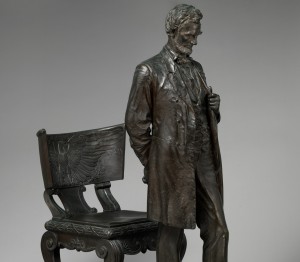Abe Lincoln Comes Home To New York City
Honest Abe, at home in the Big Apple?
Yes, we’re talking about that same tall and gangly-limbed senator from Illinois who freed the slaves and gave us a reason to celebrate every February 12th. New Yorkers have never been shy about claiming their own, and just to prove it, The Metropolitan Museum of Art has acquired the Standing Lincoln, one of only 16 known casts in the world by the famed sculptor, Augustus Saint-Gaudens.
“The Metropolitan is delighted to acquire its first major portrait of Abraham Lincoln, at the precise moment we are re-opening our redesigned galleries for American paintings, sculpture, and decorative arts,” Thomas P. Campbell, director and CEO of the museum, commented.
The statuette is in impressive company, joining a collection of more than 50 works by Saint-Gaudens. According to Thayer Tolles, the curator of American Painting and Sculpture at the Met, this is “the one that proclaimed Saint-Gaudens as an artist of international stature.”
Lincoln at the Met
When one first enters the Peter M. Sacerdote Gallery (devoted to the Civil War and Reconstruction eras), even before skirting the surrounding walls, the eye is greeted by that somber and dignified likeness. No wonder one approaches with a certain reverence. Anyone educated in the States can remember that unmistakable poster face staring down from the classroom walls.
Jose Villanueva, a seventh grader in the Bronx, originally from the Dominican Republic, was willing to offer his own slant on the subject.
“Lincoln is important to me because of what he did for the Blacks. If he didn’t free the slaves, I wouldn’t have friends like you,” he said.
Though the bronze statuette, one of a limited number authorized by the artist under the terms of his estate, stands only 40-1/2 inches high, its presence is unmistakable. Standing in front of a klismos-type chair of state, the figure’s head is bowed, but not servile, left foot forward—as if poised to give audience to the gravest concerns of the day.
The Met’s version is a rare, authorized reduction of the larger bronze monument originally created for Lincoln Park in Chicago between 1884 and 1887. Its power on the onlooker then was instantaneous and still is. Saint-Gaudens later used the same pose for a seated statue which the museum exhibited during the centennial of Lincoln’s birth in 1909.
Two paintings hanging directly behind the statuette, on the rear wall, are a fitting tribute to Lincoln’s stand against slavery. Theodore Kaufmann’s On to Liberty from 1867 depicts a group of fleeing slaves gazing across a rock strewn path to an American flag and, presumably, freedom beyond. On a lighter note, Winslow Homer’s Dressing for the Carnival (1877) shows a colorful band of Black freemen and their children readying for the festivities to come.
Nearby, a bronze cast (once owned by Saint-Gaudens himself) of Leonard Wells Volk’s1860 life mask and cast of Lincoln’s right hand is worth mentioning. Both were consulted frequently by the artist for his own work a generation later.
The Standing Lincoln was cast between 1911 and the early 1920s by Tiffany Studios and Gorham Manufacturing Company. After his death, his widow marketed supervised reproductions for museum, library, and domestic display. The Met’s own cast was originally in the collection of Clara Stone Hay, the widow of Lincoln’s onetime assistant private secretary, John M. Hay, who later co-authored a ten-volume biography of the President.
But what of Lincoln as everyman, not brushed off and bronzed for the ages?
Lincoln in New York City
George Haven Putnam, a contemporary of Lincoln’s, recalls that when the senator from Illinois visited New York on Feb. 25, 1860, in order to give his first speech at Cooper Union’s Great Hall two nights later, “no one met him when he stepped off the ferry at Cortlandt Street. He unobtrusively found his own way to the Astor House.” Situated between Vesey and Barclay Streets, it was unquestionably the most fashionable hotel of the day. Andrew A. Freeman in his 1960 biography of the President, Abraham Lincoln Goes to New York, mentions that it could accommodate 600 guests with a top price per room of two dollars.
When Lincoln visited the Plymouth Church in Brooklyn Heights the next morning, to hear the antislavery preacher Henry Ward Beecher speak before he departed, newspaperman Henry C. Bowen said that “all seemed anxious to shake hands with the senator, and hundreds did so.” It seems Lincoln was more than generous in greeting his public. Following the eventual presidential nomination, Volks did his famous hand cast of the frontiersman’s hands. Not surprisingly, he found Lincoln’s hand and knuckles swollen from all the shaking the man had endured on the trail!
According to Putnam, “rain and snow made moving around the city difficult on Monday, but Lincoln visited Know Great Hat and Cap Establishment at Broad and Fulton Street, where he received a free silk top hat. Then he went to Matthew Brady’s famed photo studio at 543 Broadway and posed for his picture.”
Lincoln later would attribute two things to his winning the presidential race: the photograph by Matthew Brady and his subsequent speech at Cooper Union.
(Article continued on next page)











